At the time of writing, Galway United sit top of the table in the Republic of Ireland’s second-tier, the League of Ireland First Division. John Caulfield’s men have started the campaign in dominant fashion, winning all of their opening five games, the highlight being a 9-1 trouncing of League of Ireland newcomers Kerry.
Galway have scored a total of 15 goals in their opening five games, conceding just twice, leaving them with the most goals scored and fewest goals conceded in their division. They’ve got the league’s best xG too (11.74 — far above the next-highest at 7.34) and lowest xGA (3.29).
All in all, it’s been a great start to the season for Galway. In this tactical analysis and team-focused scout report, we’ll have a look at one of the major aspects of The Tribesmen’s game: their defensive approach. We’ll analyse key parts of Galway’s defensive strategy and tactics to determine why it’s been such an important part of their impressive start to the season both in front of the opposition’s goal and their own goal.
Success in duels
Galway’s 70.1% defensive duel success rate places second in the league. Their aerial duel success rate is less impressive at 45.6%; still, they’ve generally been very solid when defending long balls sent from the back towards their centre-backs of right-sided Rob Slevin and left-sided Killian Brouder.
Brouder, in particular, has been dominant in the air, winning 70.1% of his aerial duels — very impressive when compared with the rest of the centre-backs in the league. Slevin’s 51.06% does need improving but still impresses more than the team’s overall aerial duel success rate, though not by much.
Galway United’s centre-back duo have respectively engaged in 8.87 (Slevin) and 8.3 (Brouder) aerial duels per 90 this term. This ranks Slevin second and Brouder fourth among League of Ireland First Division centre-backs for aerial duels per 90, a result of Galway’s intense high pressure at the other end of the pitch and how it routinely forces the opposition to go long in an attempt to beat The Tribesmen’s press.
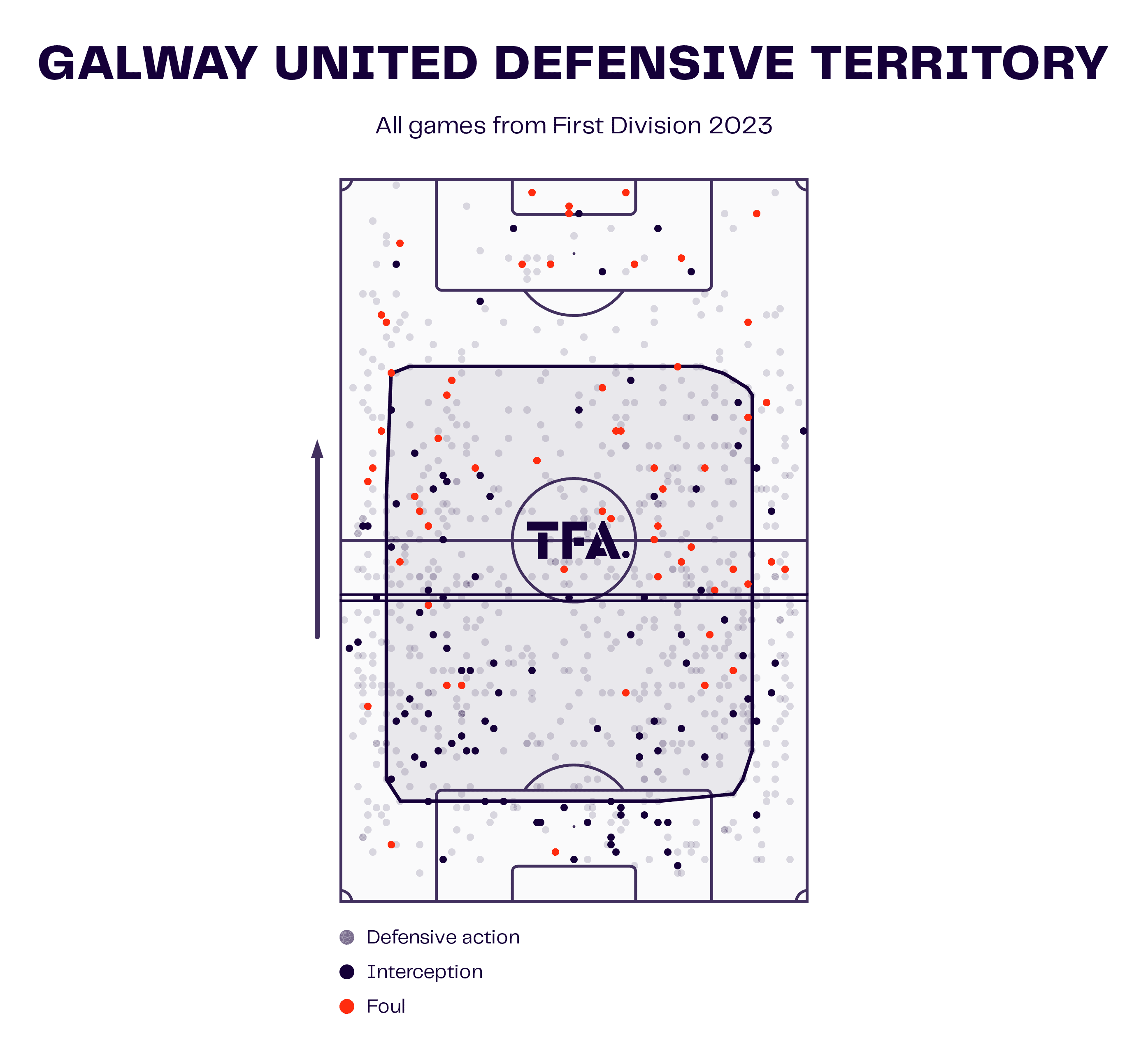
Figure 1 shows how high Galway’s average defensive line is, where their typical defensive territory is and where they’ve engaged in defensive actions so far this term. They don’t commit a tonne of fouls and tend to engage a lot in the half-spaces and wider areas, a result of them having made it very difficult to play through them centrally.
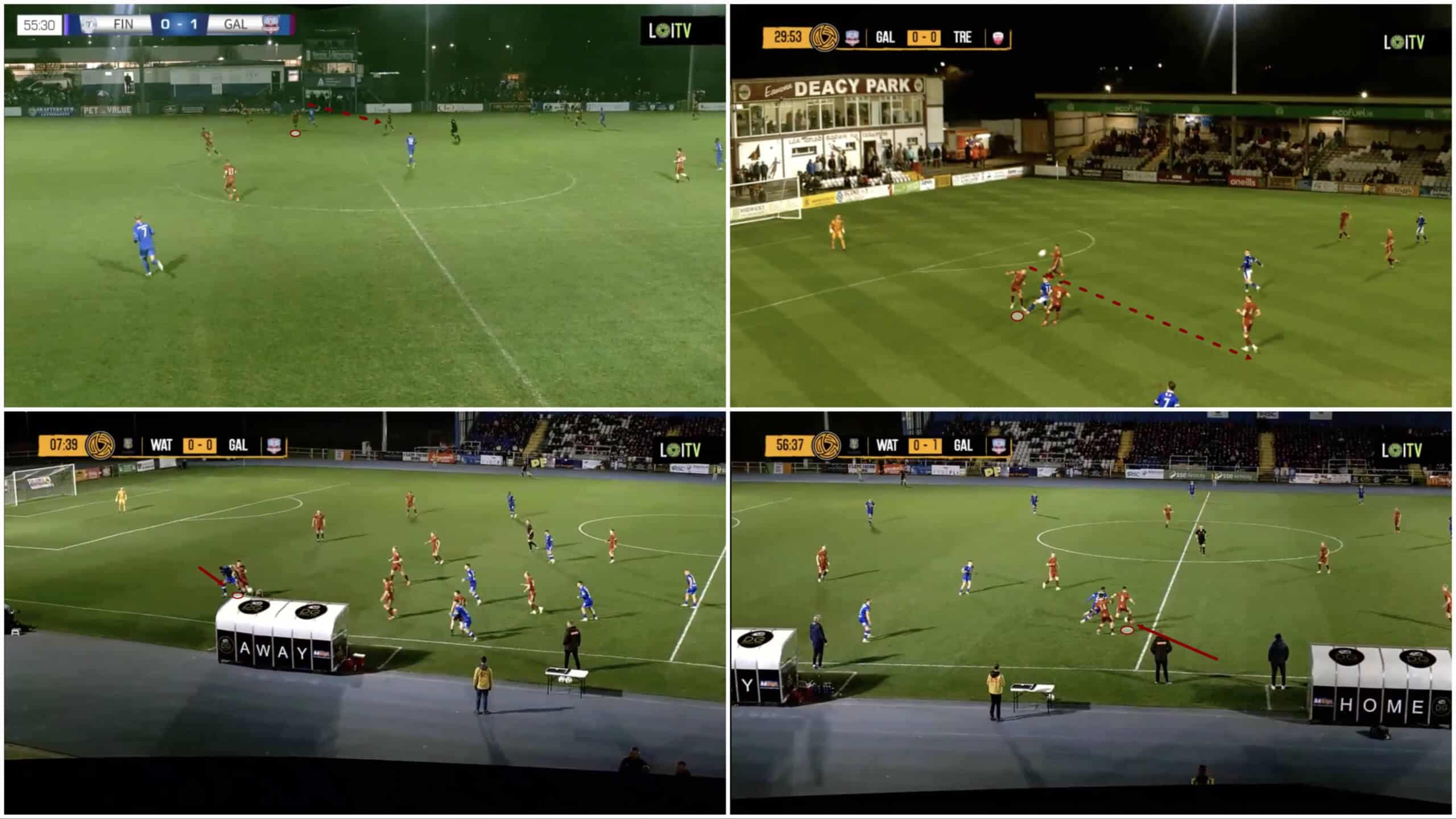
Meanwhile, figure 2 shows a couple of examples of members of Galway’s backline engaging in duels. The top two images show examples of aerial duels resulting from the opposition being forced into landing a long ball on top of Galway’s defence in the hope it causes trouble. In these cases, it never did. The centre-backs were happy to step out, they read the flight of the ball well and launched it back upfield towards a teammate.
The bottom two images show ground duels and again, Galway’s defenders performed well here. They must be ready to step out and engage attackers quickly, often tasked with dispossessing them before they’ve managed to turn on the ball and face The Tribesmen’s own goal. This is something the defenders did very well in these two examples below as the opposition received and tried to play through Galway.
High press
Galway’s PPDA sits at 6.14 for the 2023 season. This is the third-lowest PPDA in the League of Ireland First Division, essentially indicating a fairly intense level of pressing. Galway have been successful at creating goalscoring opportunities via their pressing, so it’s been a valuable tool at both ends of the pitch in one way or another.
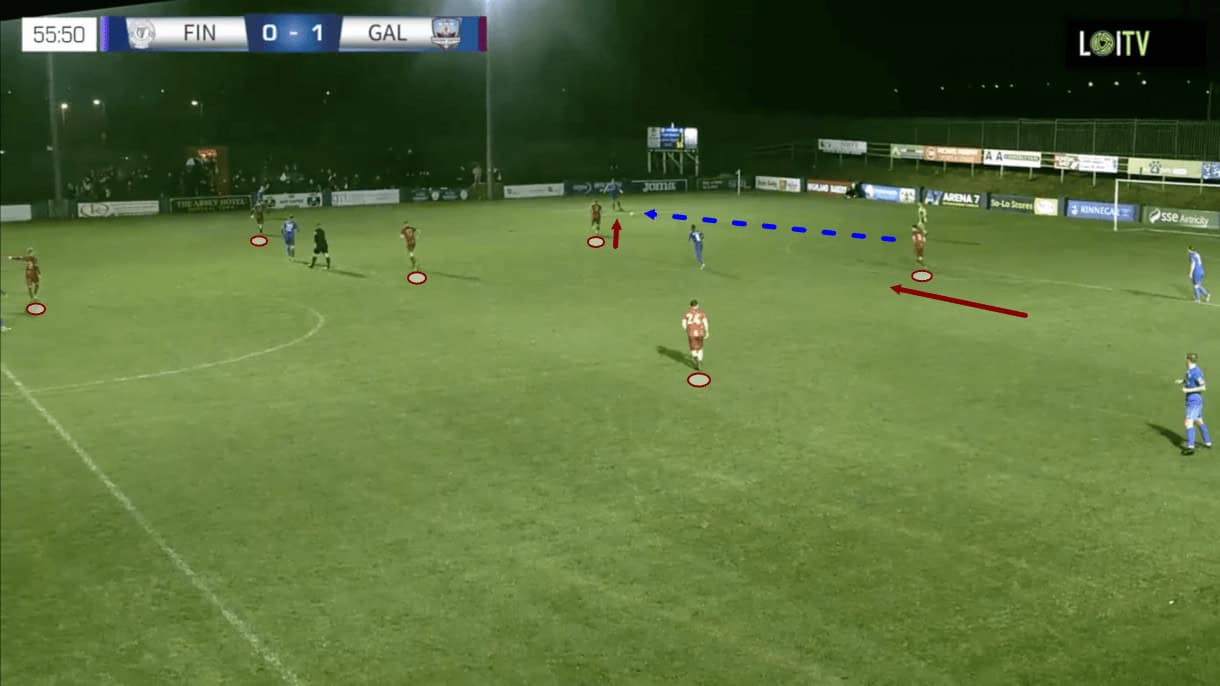
To analyse the way in which Galway press, we’ll start with this example versus Finn Harps from figures 3-4. Galway have typically defended in either a 4-2-3-1 shape or a 4-1-3-2 shape this season; we see an example of the latter in figure 3 above.
In this shape, their strikers would split to control one half of the pitch each and block passing lanes into the central Finn Harps passing option. As the ball was played out to the right centre-back, Galway’s left centre-forward burst into action.
All the time, he ensures he keeps the central passing option in his cover shadow while the right centre-forward comes across to cover that option too.
Then, the central midfielders behind will shift across to this side too, getting tight to any player that enters their zone and could become a passing option for the ball carrier.
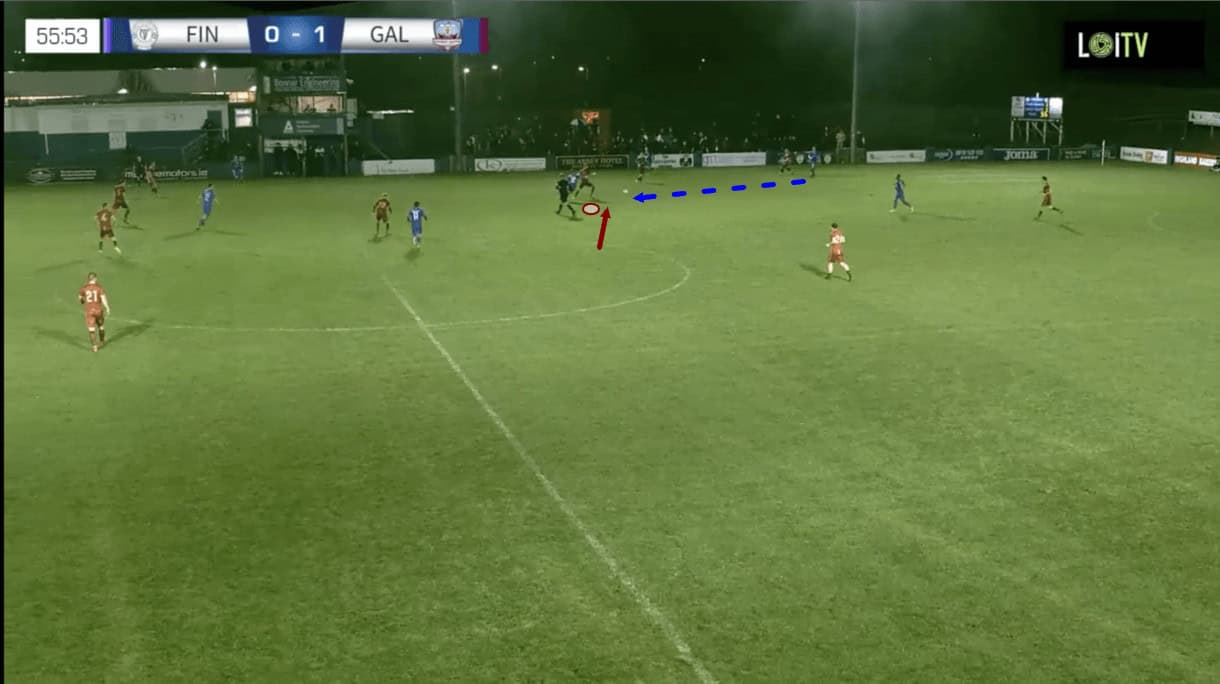
As the ball is played forward, we see Galway’s central midfielder coming across to support the left central midfielder and timing this interception perfectly. This halts Harps’ attack and sets Galway up for a dangerous counterattack.
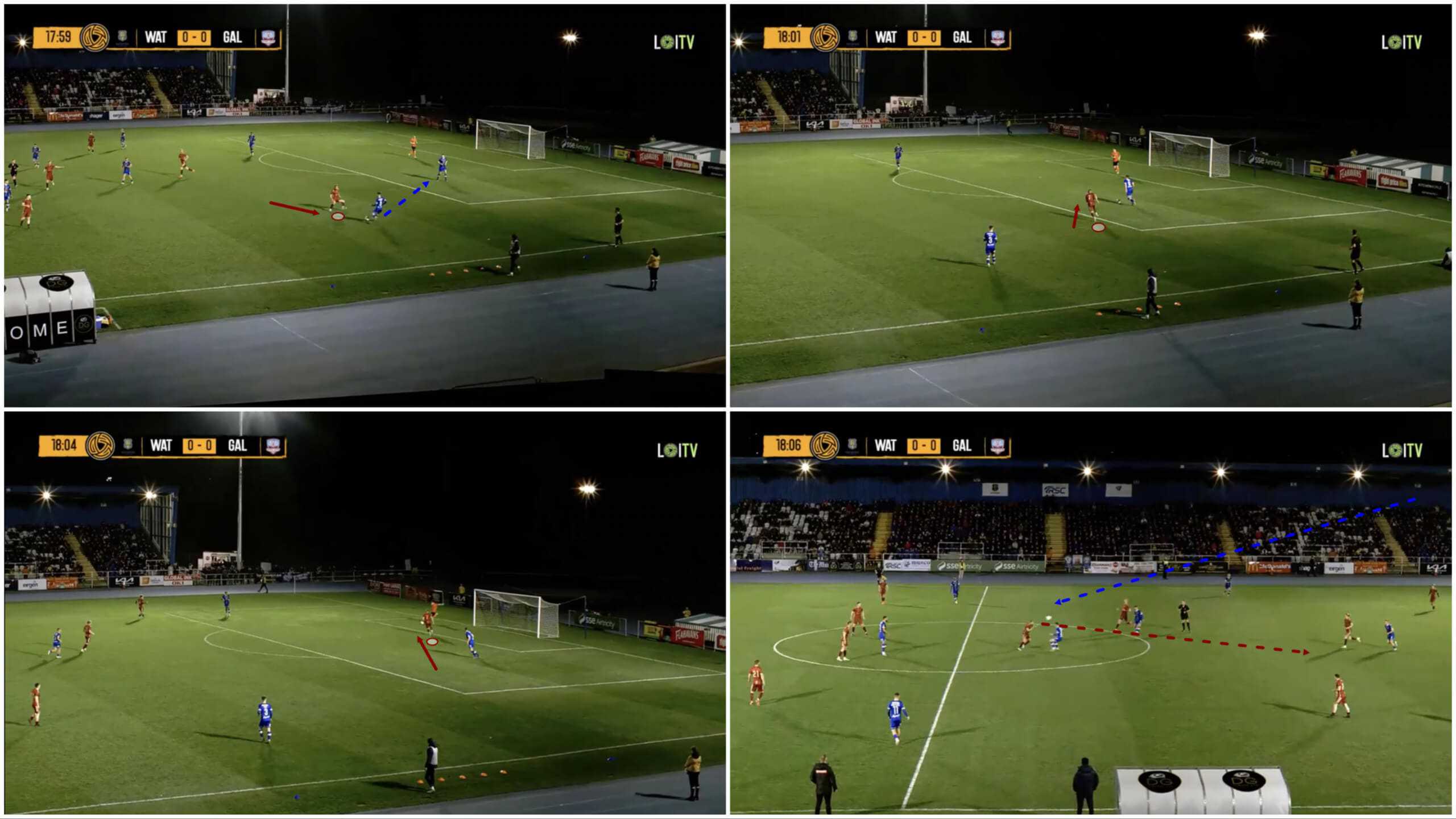
This time, versus Waterford, the ball is played out to the left by the opposition, drawing Galway’s press to the opposite side as before.
The press is led by centre-forward, 32-year-old Stephen Walsh, who’s been incredible at his role in The Tribesmen’s setup so far this term. Walsh has shown a lot of energy and closed players down with such pace that it really adds some venom and urgency to his team’s press. Additionally, he’s pressed very intelligently throughout the season, always coming at the ball carrier from an angle that closes off a relevant passing option.
We see all of this in figure 5. Firstly, he forces Waterford to move back from full-back to centre-back, then closes off the pass back to the full-back and hunts down the centre-back after they receive the ball. It’s then sent back to the ‘keeper who is again charged down aggressively and forced into a long ball upfield. This is a big part of why Galway have engaged in so many aerial duels this term.
In the end, The Tribesmen win the ball back in the air and create an opportunity to run at Waterford’s defence.
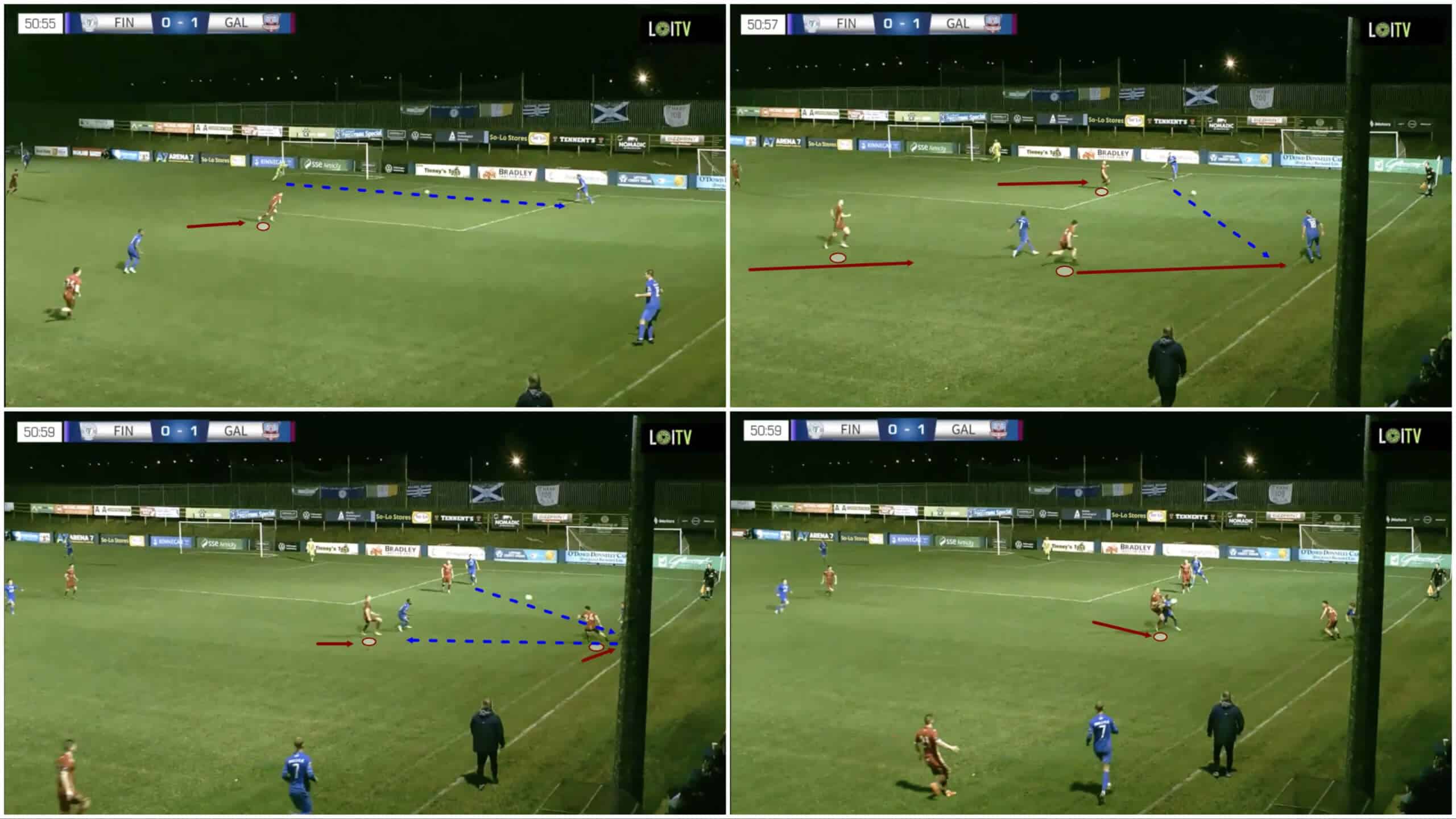
Figure 6 shows another example of Galway forcing the play out wide, this time they win it high, though. As the opposition try to play the ball through Galway’s defending players and into midfield, Galway’s central midfielder performs a well-timed interception, cutting the ball off, regaining possession and creating an opportunity for his team to run at the opposition’s defence again, starting the counter from a very favourable position in this instance.
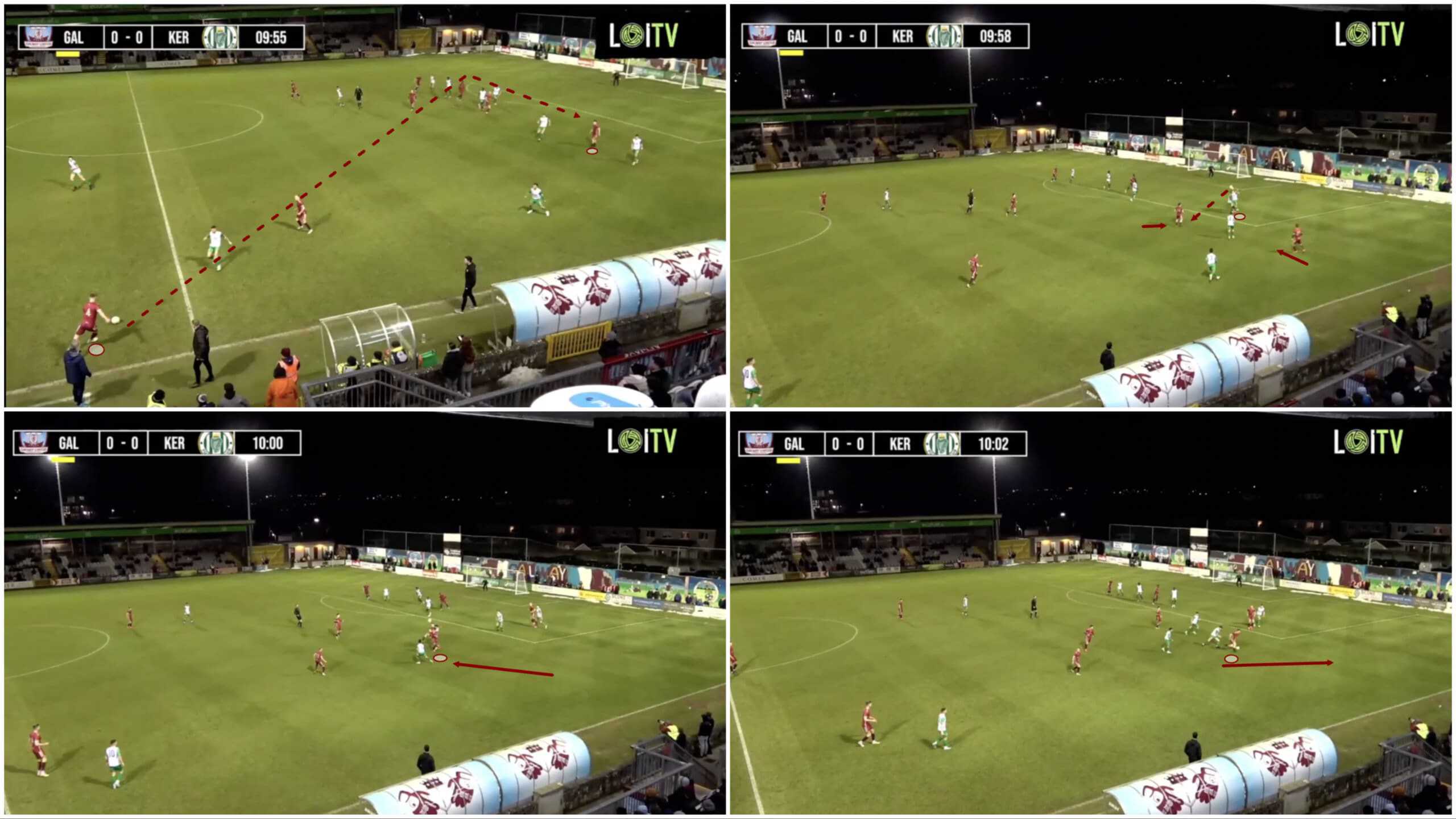
As we see here in figure 7, Galway also set up well to win second balls inside the final third. They like to target a specific player in their team and space they’d like to invade before launching a long ball into that space. Then, they need at least two men around the drop zone to attack the second ball and ensure it falls the way of their team. If it does, they can end up in a great position to establish themselves high upfield and run at the defence.
Tracking back
Our final section of analysis will stick largely with The Tribesmen’s pressing approach but will zone in on a particular aspect of it when the ball gets played beyond their first line of pressure: the way in which forwards track back.
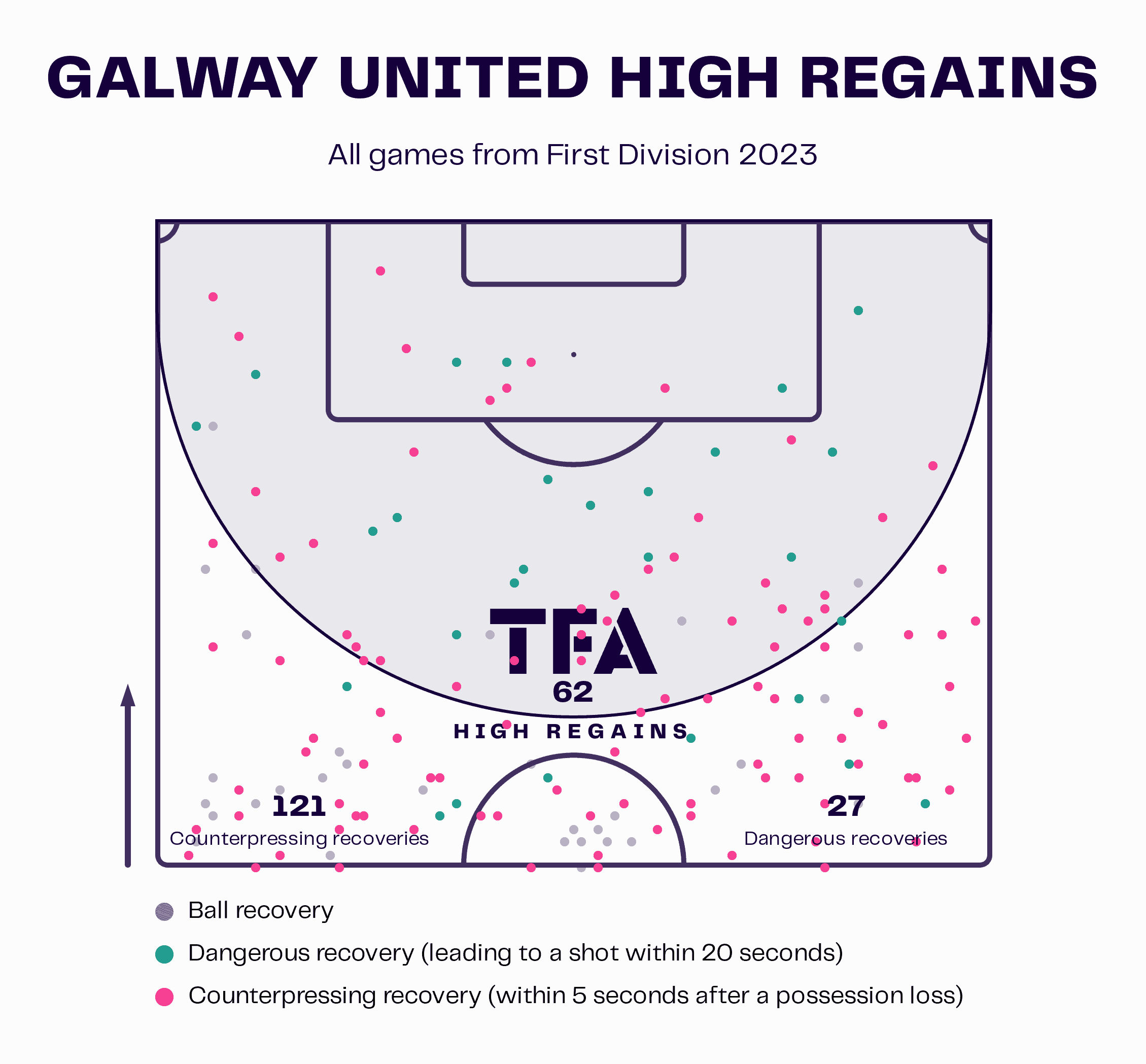
Firstly, we saw Galway’s high average defensive line marked out on figure 1. Now, in figure 8, we can see the high regains they’ve made this term resulting from this aggressive, proactive defensive approach.
Galway have made a lot of high regains in 2023, with so many (121) coming shortly after a possession loss and being counted as ‘counterpressing recoveries’ on our image above.
An important aspect of their counterpressing is the way in which the more advanced players (namely the centre-forward in higher areas like we see marked out on the image above but also the midfielders once you look at this in deeper areas) chase back and support their deeper teammates once the ball is played past them — they don’t just thrash their arms about and whinge about it, they proactively chase back after the ball and try to make a potentially game-changing difference for their team.
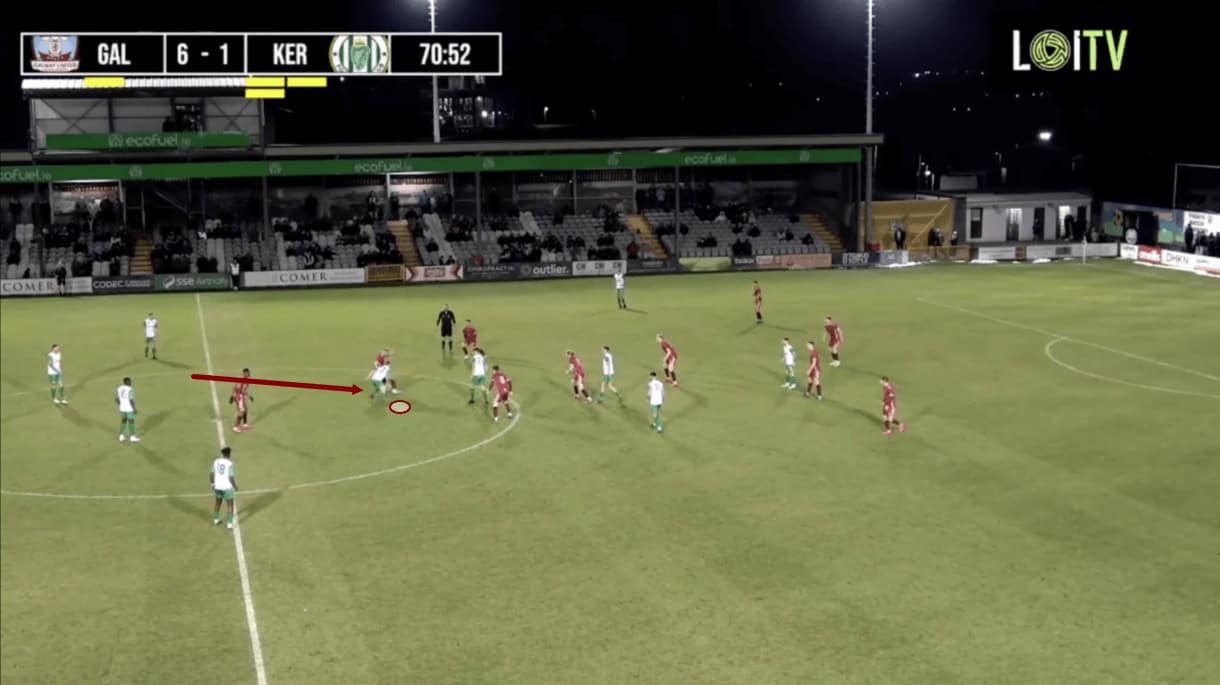
We see an example of this just inside their own half in figure 9, where Stephen Walsh has sprinted back to apply pressure on the ball carrier from behind. Meanwhile, the rest of the team can remain disciplined positionally, remaining in their respective zones and focusing on the players within them.
This is one major benefit of having so much defensive contribution from the forwards — it can prevent gaps from opening up in the team’s shape even if the first line is beaten because that first line can come back to help once more. The other defenders sometimes just need to be patient and deny the ball carrier good, clear opportunities for progression, as Caulfield’s side did here.
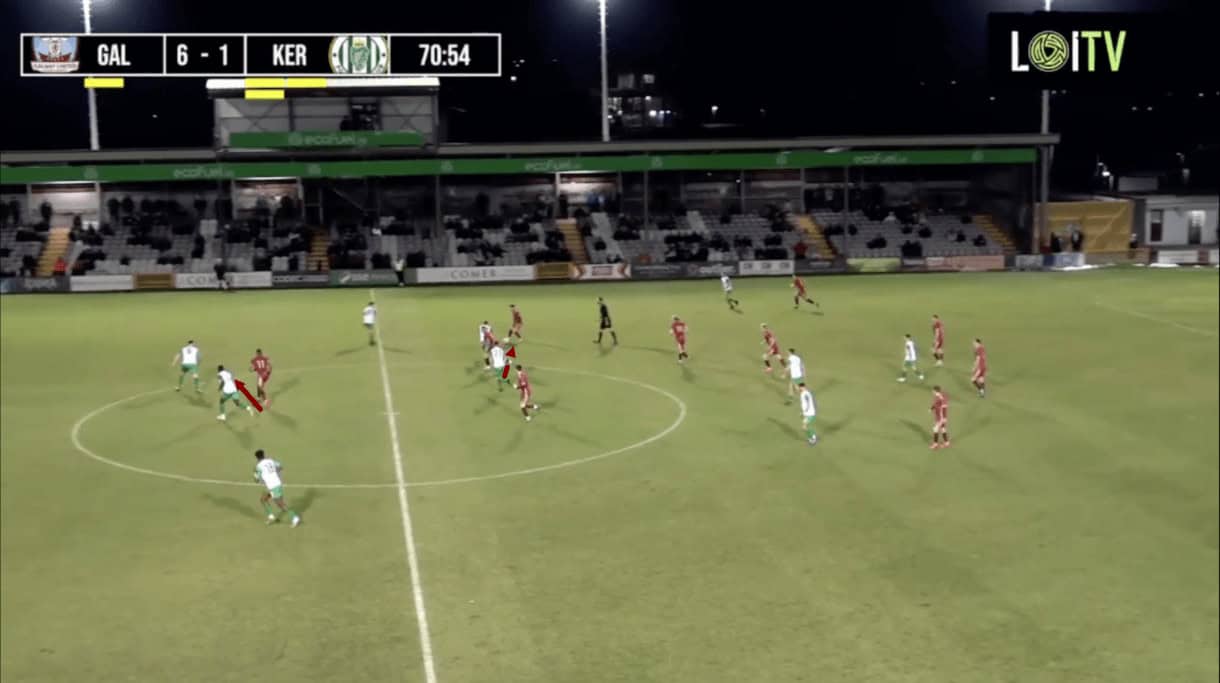
After taking the ball back, Walsh laid it off to a midfield teammate beside him while Ibrahim Keita began his run in behind. Now Galway are beginning to stretch Kerry vertically with this run in behind which can either be taken up with a through pass in the hope Keita can get in behind and exploit the Kerry defence — or be taken advantage of by playing the ball in between the lines and using the space resulting from Keita’s run.
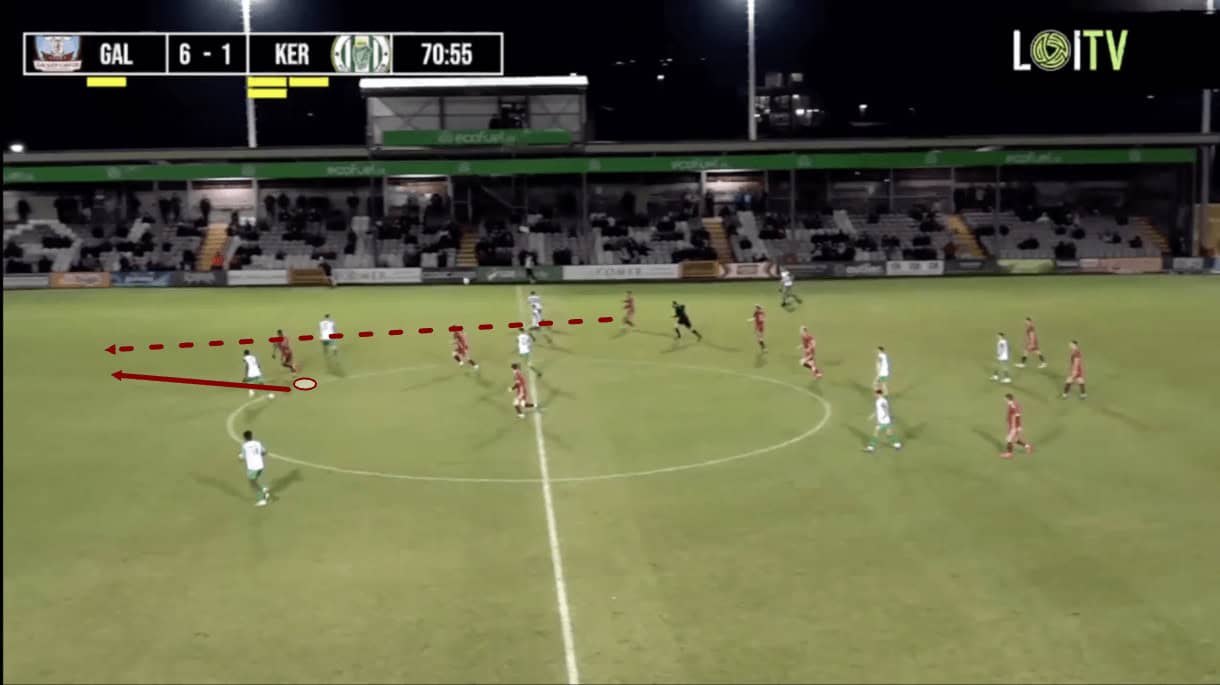
As play moves on, we see Galway opt for the former and they play Keita through on goal. This creates a good goalscoring opportunity for Galway directly resulting from their forward’s diligence to track back, get stuck in, win the ball and lay it off to a teammate who could create.
This unselfish behaviour from the centre-forward is key for this Galway team and their defensive success this term and given Walsh’s happiness to perform in such a way, that makes him an ideal fit for Caulfield’s squad.
Conclusion
To conclude this tactical analysis and team-focused scout report, we hope we’ve provided some valuable insight into one of the best pressing teams in Ireland this year. It’s not as glamorous, perhaps, as reading about the pressing at Manchester City, Liverpool, Ajax or Bayern Munich but it’s absolutely something we can all learn from, especially given their stellar start to the campaign.
Galway’s press has helped create plenty of chances for them, adding to their highly impressive goalscoring tally at this stage of the campaign, while this has also helped them to concede the fewest shots (6.23) of any League of Ireland First Division side, which has been key to their low goals against total.
Should they keep up this high level of defensive performance, we may well be seeing The Tribesmen in the Premier Division next term, so watch this space!





Comments